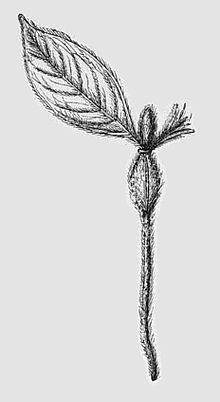- Duroia hirsuta
-
Duroia hirsuta 
Scientific classification Kingdom: Plantae (unranked): Angiosperms (unranked): Eudicots (unranked): Asterids Order: Gentianales Family: Rubiaceae Genus: Duroia Species: D. hirsuta Binomial name Duroia hirsuta
K.Schum.Duroia hirsuta is a myrmecophyte tree species from the Amazon Forest. It is one of some 37 species of Duroia which are shrubs or canopy trees in the family Rubiaceae, favouring ants (myrmecophilous), and occurring in Central America as far north as Mexico, the Amazon Basin, the Guiana Shield, the Brazilian Atlantic coast and planalto.
A number of Duroia species, and possibly all, are capable of biochemical interactions inhibiting the growth of neighbouring plants. Analysis of root extracts from Duroia hirsuta have yielded a strong plant growth inhibitor plumericin, a tetracyclic iridoid lactone, and duroin, another iridoid lactone.[1][2]
This process, common amongst plants, is termed allelopathy. In the case of Duroia hirsuta, the chemical inhibitor is aided by the leafcutter ant Myrmelachista schumanni resident on and in the tree, and playing an active role in suppressing and destroying plant growth in the vicinity of their host by injecting and spraying formic acid, and defending against herbivores - other ant species such as Azteca spp. and Allomerus octoarticulatus demerarae exhibit the same mutualism.[3] The area around this understory tree is often devoid of all other plant types, leading to the local name 'Devil's garden'.[4] The cost to the host plant for this protection is considerable, since the resident ants subject the tree to increased leaf cutting. [5] Trees that grow outside the cleared area often have the living tissues of their trunks excavated and galled for ant accommodation. [6]
External links
References
- ^ J. E. Page, S. Madrinan & G. H. N. Towers (1994). "Identification of a plant growth inhibiting iridoid lactone from Duroia hirsuta, the allelopathic tree of the 'Devil's Garden'". Experientia 50 (9): 840–842. doi:10.1007/BF01956467.
- ^ Rita Aquino, Nunziatina De Tommasi, Medardo Tapia, Maria Rosaria Lauro & Luca Rastrelli (1999). "New 3-methyoxyflavones, an iridoid lactone and a flavonol from Duroia hirsuta". Journal of Natural Products 62 (4): 560–562. doi:10.1021/np9803631. PMID 10217708. http://pubs.acs.org/doi/abs/10.1021/np9803631.
- ^ Megan E. Frederickson (2005). "Ant species confer different partner benefits on two neotropical myrmecophytes". Oecologia 143 (3): 387–395. doi:10.1007/s00442-004-1817-7. JSTOR 20062261. PMID 15711821.
- ^ David G. Campbell, P. Mick Richardson & Arito Rosas, Jr (1989). "Field screening for allelopathy in tropical forest trees, particularly Duroia hirsuta, in the Brazilian Amazon". Biochemical Systematics and Ecology 17 (5): 403–407. doi:10.1016/0305-1978(89)90057-4.
- ^ Megan E. Frederickson & Deborah M. Gordon (2007). "The devil to pay: a cost of mutualism with Myrmelachista schumanni ants in ‘devil's gardens’ is increased herbivory on Duroia hirsuta trees". Proceedings of the Royal Society B 274 (1613): 1117–1123. doi:10.1098/rspb.2006.0415. PMC 2124481. PMID 17301016. http://rspb.royalsocietypublishing.org/content/274/1613/1117.short.
- ^ "Ants are friendly to some trees, but not others". Science Daily. November 9, 2009. http://www.sciencedaily.com/releases/2009/11/091107115833.htm. Retrieved May 3, 2011.
Categories:- Rubiaceae
- Plants described in 1888
Wikimedia Foundation. 2010.
